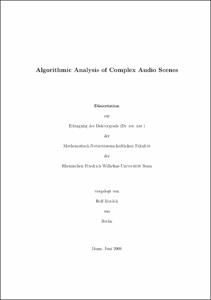Bardeli, Rolf: Algorithmic Analysis of Complex Audio Scenes. - Bonn, 2008. - Dissertation, Rheinische Friedrich-Wilhelms-Universität Bonn.
Online-Ausgabe in bonndoc: https://nbn-resolving.org/urn:nbn:de:hbz:5N-15711
Online-Ausgabe in bonndoc: https://nbn-resolving.org/urn:nbn:de:hbz:5N-15711
@phdthesis{handle:20.500.11811/3696,
urn: https://nbn-resolving.org/urn:nbn:de:hbz:5N-15711,
author = {{Rolf Bardeli}},
title = {Algorithmic Analysis of Complex Audio Scenes},
school = {Rheinische Friedrich-Wilhelms-Universität Bonn},
year = 2008,
note = {In this thesis, we examine the problem of algorithmic analysis of complex audio scenes with a special emphasis on natural audio scenes. One of the driving goals behind this work is to develop tools for monitoring the presence of animals in areas of interest based on their vocalisations. This task, which often occurs in the evaluation of nature conservation measures, leads to a number of subproblems in audio scene analysis.
In order to develop and evaluate pattern recognition algorithms for animal sounds, a representative collection of such sounds is necessary. Building such a collection is beyond the scope of a single researcher and we therefore use data from the Animal Sound Archive of the Humboldt University of Berlin. Although a large portion of well annotated recordings from this archive has been available in digital form, little infrastructure for searching and sharing this data has been available. We describe a distributed infrastructure for searching, sharing and annotating animal sound collections collaboratively, which we have developed in this context.
Although searching animal sound databases by metadata gives good results for many applications, annotating all occurences of a specific sound is beyond the scope of human annotators. Moreover, finding similar vocalisations to that of an example is not feasible by using only metadata. We therefore propose an algorithm for content-based similarity search in animal sound databases. Based on principles of image processing, we develop suitable features for the description of animal sounds. We enhance a concept for content-based multimedia retrieval by a ranking scheme which makes it an efficient tool for similarity search. One of the main sources of complexity in natural audio scenes, and the most difficult problem for pattern recognition, is the large number of sound sources which are active at the same time. We therefore examine methods for source separation based on microphone arrays. In particular, we propose an algorithm for the extraction of simpler components from complex audio scenes based on a sound complexity measure.
Finally, we introduce pattern recognition algorithms for the vocalisations of a number of bird species. Some of these species are interesting for reasons of nature conservation, while one of the species serves as a prototype for song birds with strongly structured songs.},
url = {https://hdl.handle.net/20.500.11811/3696}
}
urn: https://nbn-resolving.org/urn:nbn:de:hbz:5N-15711,
author = {{Rolf Bardeli}},
title = {Algorithmic Analysis of Complex Audio Scenes},
school = {Rheinische Friedrich-Wilhelms-Universität Bonn},
year = 2008,
note = {In this thesis, we examine the problem of algorithmic analysis of complex audio scenes with a special emphasis on natural audio scenes. One of the driving goals behind this work is to develop tools for monitoring the presence of animals in areas of interest based on their vocalisations. This task, which often occurs in the evaluation of nature conservation measures, leads to a number of subproblems in audio scene analysis.
In order to develop and evaluate pattern recognition algorithms for animal sounds, a representative collection of such sounds is necessary. Building such a collection is beyond the scope of a single researcher and we therefore use data from the Animal Sound Archive of the Humboldt University of Berlin. Although a large portion of well annotated recordings from this archive has been available in digital form, little infrastructure for searching and sharing this data has been available. We describe a distributed infrastructure for searching, sharing and annotating animal sound collections collaboratively, which we have developed in this context.
Although searching animal sound databases by metadata gives good results for many applications, annotating all occurences of a specific sound is beyond the scope of human annotators. Moreover, finding similar vocalisations to that of an example is not feasible by using only metadata. We therefore propose an algorithm for content-based similarity search in animal sound databases. Based on principles of image processing, we develop suitable features for the description of animal sounds. We enhance a concept for content-based multimedia retrieval by a ranking scheme which makes it an efficient tool for similarity search. One of the main sources of complexity in natural audio scenes, and the most difficult problem for pattern recognition, is the large number of sound sources which are active at the same time. We therefore examine methods for source separation based on microphone arrays. In particular, we propose an algorithm for the extraction of simpler components from complex audio scenes based on a sound complexity measure.
Finally, we introduce pattern recognition algorithms for the vocalisations of a number of bird species. Some of these species are interesting for reasons of nature conservation, while one of the species serves as a prototype for song birds with strongly structured songs.},
url = {https://hdl.handle.net/20.500.11811/3696}
}






